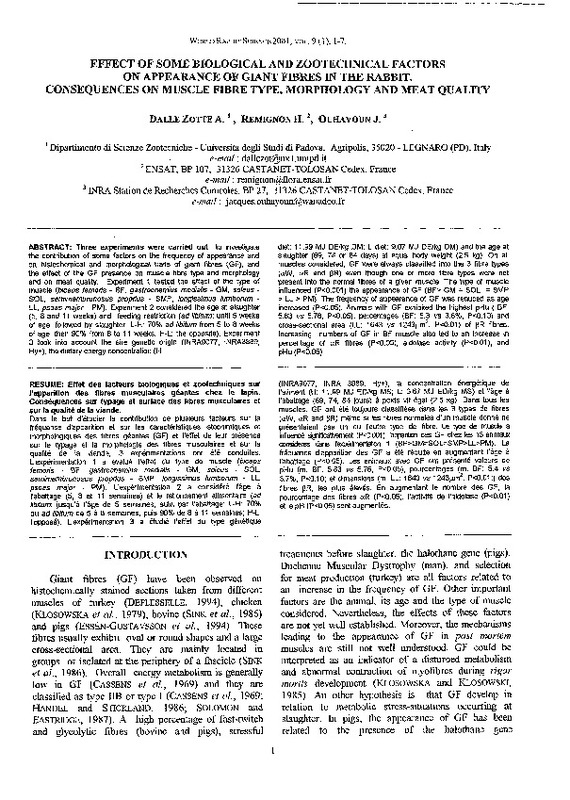JavaScript is disabled for your browser. Some features of this site may not work without it.
Buscar en RiuNet
Listar
Mi cuenta
Estadísticas
Ayuda RiuNet
Admin. UPV
EFFECT OF SOME BIOLOGICAL AND ZOOTECHNICAL FACTORS ON APPEARANCE OF GIANT FIBRES IN THE RABBIT. CONSEQUENCES ON MUSCLE FIBRE TYPE, MORPHOLOGY AND MEAT QUALITY
Mostrar el registro sencillo del ítem
Ficheros en el ítem
| dc.contributor.author | Dalle Zotte, A.
|
|
| dc.contributor.author | Remignon, H.
|
|
| dc.contributor.author | Ouhayoun, J.
|
|
| dc.date.accessioned | 2011-03-02T16:08:32Z | |
| dc.date.available | 2011-03-02T16:08:32Z | |
| dc.date.issued | 2001 | |
| dc.identifier.issn | 1257-5011 | |
| dc.identifier.uri | http://hdl.handle.net/10251/10144 | |
| dc.description.abstract | [EN] Three experiments were carried out to investigate the contribution of sorne factors on the frequency of appearance and on histochemical and morphological traits of giant fibres (GF), and the effect of the GF presence on muscle fibre type and morphology and on meat quality. Experiment 1 tested the effect of the type of muscle (bíceps femoris - BF, gastrocnemius media/is - GM, so/eus - SOL, semimembronosus proprius - SMP, longissimus /umborum - LL, psoas major - PM). Experiment 2 considered the age at slaughter (5, 8 and 11 weeks) and feeding restriction (ad libitum: until 5 weeks of age, followed by slaughter; L-H: 70% ad libitum from 5 to 8 weeks of age, then 90% from 8 to 11 weeks; H-L: the opposite). Experiment 3 took into account the sire genetic origin (INRA9077, INRA3889, Hy+), the dietary energy concentration (H diet: 11.99 MJ DE/kg DM; L diet: 9.67 MJ DE/kg DM) and the age at slaughter (69, 74 or 84 days) at equal body weight (2.5 kg). On all muscles considered, GF were always classified into the 3 fibre types (a.W, a.R and J3R) even though ene or more fibre types were not present into the normal fibres of a given muscle. The type of muscle infiuenced (P<0.001) the appearance of GF (BF> GM =SOL = SMP > LL > PM). The frequency of appearance of GF was reduced as age increased (P<0.05). Animals with GF exhibited the highest pHu ( BF: 5.83 vs 5.76, P<0.05), percentages (BF: 5.3 vs 3.6%, P<0.10) and cross-sectional area (LL: 1643 vs 1243~1m2 , P<0.01) of J3R fibres. lncreasing numbers of GF in BF muscle also led to an increase in percentage of a.R fibres (P<0.05), aldolase activity (P<0.01 ), and pHu (P<0.05). | es_ES |
| dc.description.abstract | [FR] Dans le but d'étudier la contribution de plusieurs facteurs sur la fréquence d'apparition et sur les caractéristiques istochimiques et morphologiques des fibres géantes (GF) et l'effet de leur présence sur le typage et la morphologie des fibres musculaires et sur la qualité de la viand~. 3 expérimentations ont été conduites. L'expérimentation 1 a évalué l'effet du type de muscle (bíceps femoris - BF, gastrocnemius media/is - GM, so/eus - SOL, semimembronosus proprius - SMP, /ongissimus lumborum - LL, psoas major - PM). L'expérimentation 2 a considéré l'áge a l'abattage (5, 8 et 11 semaines) et le rationnement alimentaire (ad libitum: jusqu'a l'áge de 5 semaines, suivi par l'abattage; L-H: 70% du ad libitum de 5 a 8 semaines, puis 90% de 8 a 11 semaines; H-L: l'opposé). L'expérimentation 3 a étudié l'effet du type génétique (INRA9077, INRA 3889, Hy+), la concentration énergétique de l'aliment (H: 11.99 MJ ED/Kg MS; L: 9.67 MJ ED/kg MS) et l'áge a l'abattage (69, 74, 84 jours) a poids vif égal (2.5 kg). Dans tous les muscles, GF ont été toujours classifiées dans les 3 types de fibres (a.W, a.R and J3R) meme si les fibres normales d'un muscle donné ne présentaient pas un ou l'autre type de fibre. Le type de muscle a influencé significalivement (P<0.001) l'apparition des GF chez les 13 animaux considérés dans rexpérimentation 1 (BF>GM=SOL=SMP>LL>PM). La fréquence d'apparition des GF a été réduite en augmentant l'age a l'abattage (P<0.05). Les animaux avec GF ont présenté valeurs de pHu (m. BF: 5.83 vs 5.76, P<0.05), pourcentages (m. BF: 5.4 vs 3.7%, P<0.1 O) et dimensions (m. LL: 1643 vs 1243μm2 , P<0.01 ;) des fibres J3R, les plus élevés. En augmentant le nombre des GF, la pourcentage des fibres a.R (P<0.05), l'activité de l'aldolase (P<0.01) et le pH (P<0.05) sont augmentés. | |
| dc.language | Inglés | es_ES |
| dc.publisher | World Rabbit Science. ICTA. UPV | es_ES |
| dc.relation.ispartof | World Rabbit Science | |
| dc.rights | Reserva de todos los derechos | es_ES |
| dc.title | EFFECT OF SOME BIOLOGICAL AND ZOOTECHNICAL FACTORS ON APPEARANCE OF GIANT FIBRES IN THE RABBIT. CONSEQUENCES ON MUSCLE FIBRE TYPE, MORPHOLOGY AND MEAT QUALITY | es_ES |
| dc.type | Artículo | es_ES |
| dc.date.updated | 2011-03-02T16:05:43Z | |
| dc.identifier.doi | 10.4995/wrs.2001.439 | |
| dc.rights.accessRights | Abierto | es_ES |
| dc.description.bibliographicCitation | Dalle Zotte, A.; Remignon, H.; Ouhayoun, J. (2001). EFFECT OF SOME BIOLOGICAL AND ZOOTECHNICAL FACTORS ON APPEARANCE OF GIANT FIBRES IN THE RABBIT. CONSEQUENCES ON MUSCLE FIBRE TYPE, MORPHOLOGY AND MEAT QUALITY. World Rabbit Science. 9(1). https://doi.org/10.4995/wrs.2001.439 | es_ES |
| dc.description.accrualMethod | SWORD | es_ES |
| dc.relation.publisherversion | https://doi.org/10.4995/wrs.2001.439 | |
| dc.description.volume | 9 | |
| dc.description.issue | 1 | |
| dc.identifier.eissn | 1989-8886 | es_ES |








